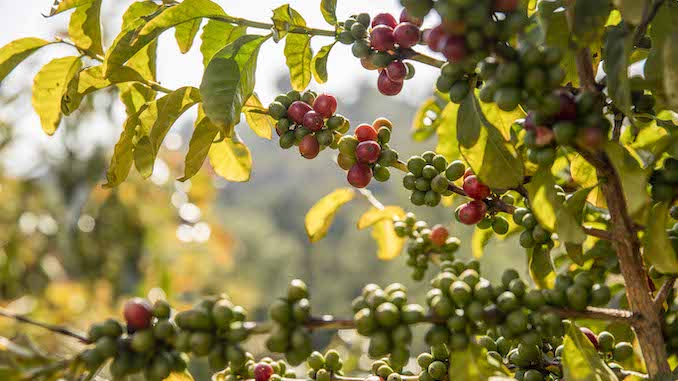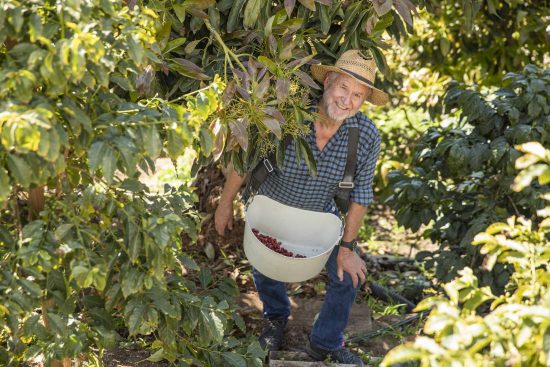
More than 70 farms are putting in the extra work to successfully grow three varieties of Gesha in California.
BY JULIA MALLON
SPECIAL TO BARISTA MAGAZINE ONLINE
Photos courtesy of Michael Haber
Every day, farm owner Mike Masino steps outside into a sweet aroma coming from his steep farm terrain of blooming coffee plants. The Santa Barbara, Calif.-based farm is filled with rows of avocados and shrubs with Gesha coffee cherries that he hand-picks himself. The Gesha has a rich, jasmine-like scent, and has tasting notes of honeycomb, bergamot, and vanilla cola.
“The first pourover we ever had was Gesha. Both my wife and I hadn’t ever experienced a coffee like that in our lives,” says Mike, who has partnered with Jay Ruskey to grow Gesha for Ruskey’s brand, Frinj Coffee. “It’s a lot of work, it doesn’t produce a lot of cherries, but the cherries are so sweet. I just really love that coffee.”

Gesha in California
Gesha is one of the most exclusive coffees in the world, and it is growing in Southern California. California farmers have to work hard to establish proper growing and cultivating techniques that would produce a high-quality Gesha. There are approximately 70 California farms that now grow coffee.
“Being a California coffee farmer truly is a labor of love,” Mike says. Gesha is difficult to grow because it is susceptible to high winds and is labor intensive. Mike lost half of his first 500 trees when he began growing Gesha at his farm, Rancho Delfino, in 2015.
“I knew it was my fault it failed. I was really excited to grow it, so it really was just a challenge,” Mike says of his first crop. Since combating issues of erosion and snail infestations, Mike now produces a Gesha that has been highly rated by the internal team at Frinj.
“It’s definitely special in the sense of the rarity of it … not many people have tried coffee that’s grown on the continental U.S.” says Andrew Pautler, who tasted and rated Good Land Organics’ (Goleta, Calif.) Gesha on his all-things-coffee site Pull & Pour.
“The best coffees are multifaceted,” says Andrew. “A lot of Geshas will have big floral notes paired with other subtle fruits or other kinds of notes that accompany, and I think that this was a great example of that.”
The multifaceted flavor of Gesha, though, comes at a high cost due to the cost of production. Frinj Coffee sells three varieties of Gesha from different farms all priced at $80 for a 5-ounce bag. Bird Rock Coffee Roasters, another California-based roaster, has sold out of the Mraz Family Farm Gesha grown in San Diego for $199 for 4 ounces.
“Flowering to harvest is something like 11 to 13 months as opposed to eight to 10 months,” says Plant Sciences Professor Patrick Brown of the UC Davis Coffee Center. “However, they’ve found it actually enhances quality by having a longer maturation, but it increases the cost of production because you’ve got fewer cycles of berries and you have to manage them for a longer time.”
Making Coffee-Growing Successful in California
One strategy that California farmers are often using to protect coffee plants is called agroforestry, or intercropping. “It has the advantage of shading trees and protecting them from wind. That tends to give you more resilience and the ability to tolerate climate extremes,” says Patrick. Freezing temperatures at night are another common issue. Structures like shade cloths or plastic cloths can help protect the trees.
Jacob White is part of the Bird Rock Coffee Roasters sourcing team and had a cupping of the Mraz Family Farm coffees. “To actually have a table of different coffee varieties, expressing different attributes that we recognize as being unique to each variety, that’s a sign of farming that’s going very well,” says Jacob.
“This isn’t coffee that you’re going to get up and drink in the morning,” says Mike. “It’s coffee you’re going to have a pourover with friends in the afternoon or in the evening, just like you would share a bottle of wine.”
ABOUT THE AUTHOR
Julia Mallon (she/her) is a freelance journalist covering lifestyle and contributing to food blogs. When she’s not working on local stories at coffee shops, she’s planning her future travels both locally and internationally.

